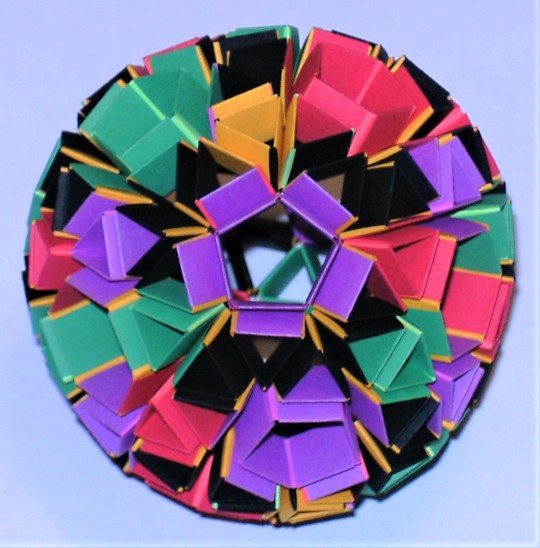#triakis tetrahedron
Text

I cleaned up the triakis tetrahedron drawing.
#polyhedron#polyhedron drawing#math#geometry#mathematics#triakis tetrahedron#catalan solid#polyhedra
42 notes
·
View notes
Text
Regular-ish Convex Polyhedra Bracket — Round 1
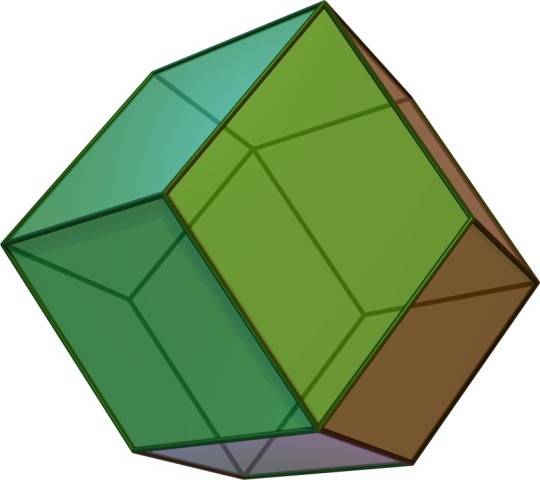

Rhombic Dodecahedron:
Catalan Solid
Dual of a quasiregular polyhedron
Dual of the Cuboctahedron
It has 12 rhombic faces, 24 edges, and 14 vertices of two types.
One of the 9 edge-transitive convex polyhedra along with the 5 Platonic Solids, the 2 Quasiregular Convex Polyhedra, and the Rhombic Triacontahedron
A space-filling tessellation/honeycomb of Euclidian three-space.
Image Credit: Cyp
Triakis Tetrahedron:
Also called the Kistetrahedron
Catalan Solid
Dual of the Truncated Tetrahedron
It has 12 isosceles triangular faces, 18 edges, and 8 vertices of two types.
Image Credit: Cyp
8 notes
·
View notes
Text
The Compound of the Platonic Tetrahedron and the Triakis Tetrahedron
The Compound of the Platonic Tetrahedron and the Triakis Tetrahedron
I made this compound using Stella 4d, which you can try for free at this website.

View On WordPress
2 notes
·
View notes
Link
A really chill normal shape.
1 note
·
View note
Photo

These shapes are Archimedean duals. They have congruent faces and regular corners, as a converse to the Archimedean solids themselves. In order of size they are triakis tetrahedron (smallest, dual to the truncated tetrahedron), the tetrakis hexahedron (on the right dual to the truncated octahedron), and the triakis octahedron. There are thirteen Archimedean duals, each paired with an Archimedean solid, and not including the Platonic solids (which are duals of each other).
4 notes
·
View notes
Text
Amy Meier’s Geometric Objects for Stone Yard, Inc.
Rancho Santa Fe based interior designer Amy Meier recently partnered with Stone Yard, Inc.’s Mitch Brean on a collection of geometric objects made of glass fiber reinforced concrete (GFRC) with an antiqued plaster “Gesso” finish. The pair had worked together in the past on custom furnishings and with a shared affection for all things geometric, the hand-carved collaboration was a natural fit. Merging contemporary shapes with an aged finish was the perfect contrast to bring together the series of five sculptural objects.
Meier, on the inspiration:
Last spring I was walking through the Parisian flea market Saint Paul Marché and found the most interesting plaster models that art students use to sketch and study shapes. They were so simple, but had this beautiful patina, a hallmark of real age but the geometric shapes felt so contemporary. I loved that contrast.
From Brean about the handcrafting process:
I like to start with a model made of cardboard, wood, or paper — anything I can use to play around with the shape before it goes to production. To get the finish Amy wanted for these shapes, we worked together and came up with a few incarnations before landing on that beautiful gesso finish. She wanted it to look like plaster that’s been around for a while.
Forme No.1 (Irregular Triangle Pyramid) 11.5″H x 8.25″L x 10.5″W
The leaning pyramid sharply points to the sky, leaving the other two sides in shadow.
Forme No.2 (Icosahedron) 6.5″W x 6.5″ H
The icosahedron boasts 20 faces, 30 edges, and 12 vertices that create all kinds of plays on shadow and light.
Forme No.3 (Slanted Cylinder) 6″D x 4″-7″H
Its cylindrical form is capped with a sloped top that creates a dramatic moment for the typically minimalist shape.
Forme No.4 (Triakis Tetrahedon) 9 5/8″ L x 8.5″H
Much like a crystal or a gemstone, this tetrahedron easily sits on its numerous sides while displaying multiple facets.
Forme No.5 (Sphere) 3″ flat base with 7.5″D
The simple sphere is the result of being curved and smoothed into its globe-like shape.
via http://design-milk.com/
from WordPress https://connorrenwickblog.wordpress.com/2017/04/11/amy-meiers-geometric-objects-for-stone-yard-inc/
0 notes
Text
Two things to show at once:
- I started to draw Catalan Solids, with the Triakis Tetrahedron being the first one.
- A foldable drawing board
One side is for the main content, the other side is for quick notes (as memory aid etc):

(can be folded)


- - -- ---
And here is the Triakis Tetrahedron drawing:

21 notes
·
View notes
Text
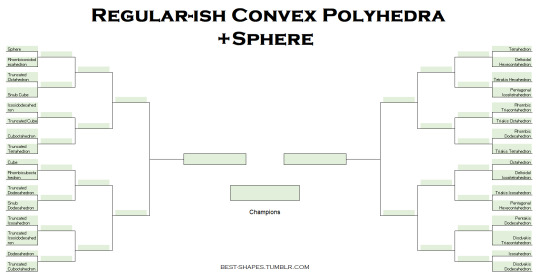
Regular-ish Convex Polyhedra (with bonus sphere) Bracket
The bracket has been seeded!
Round 1:
Sphere vs Rhombicosidodecahedron
Truncated Octahedron vs Snub Cube
Icosidodecahedron vs Truncated Cube
Cuboctahedron vs Tetrahedron
Cube vs Rhombicuboctahedron
Truncated Dodecahedron vs Snub Dodecahedron
Truncated Icosahedron vs Truncated Icosidodecahedron
Dodecahedron vs Truncated Cuboctahedron
Tetrahedron vs Deltoidal Hexecontahedron
Tetrakis Hexahedron vs Pentagonal Icositetrahedron
Rhombic Triacontahedron vs Triakis Octahedron
Rhombic Dodecahedron vs Triakis Tetrahedron
Octahedron vs Deltoidal Icositetrahedron
Triakis Icosahedron vs Pentagonal Hexecontahedron
Pentakis Dodecahedron vs Disdyakis Triacontahedron
Icosahedron vs Disdyakis Dodecahedron
#Tumblr Bracket#Tumblr Tournament#shapes#geometry#polyhedra#polytopes#Platonic Solids#Archimedean Solids#Catalan Solids#Round 1
16 notes
·
View notes
Text
Regular-ish Convex Polyhedra Bracket — Round 1


Propaganda
Cuboctahedron:
Archimedean Solid
Quasiregular
Dual of the Rhombic Dodecahedron
It has 6 square faces, 8 regular triangular faces, 24 edges, and 12 vertices.
Vertex-Transitive AND Edge-Transitive.
Image Credit: Cyp
Truncated Tetrahedron:
Archimedean Solid
Semiregular
Dual of the Triakis Tetrahedron
It has 4 regular hexagonal faces, 4 regular triangular faces, 18 edges, and 12 vertices.
Image Credit: Cyp
8 notes
·
View notes
Photo
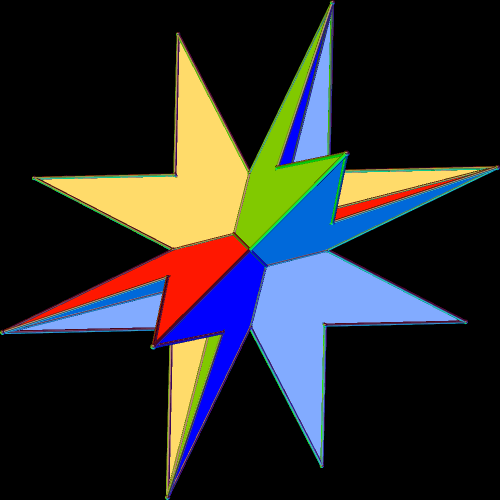
The 12th Stellation of the Triakis Tetrahedron Created using Stella 4d, which you can try for free at
2 notes
·
View notes
Text
In a kite-rhombus solid, or KRS, all faces are either kites or rhombi, and there are at least some of both of these quadrilateral-types as faces. I have found eight such polyhedra, all of which are formed by creating the convex hull of different Archimedean-Catalan base-dual compounds. Not all Archimedean-Catalan compounds produce kite-rhombus solids, but one of the eight that does is derived from the truncated dodecahedron, as explained below.

The next step is to create the compound of this solid and its dual, the triakis icosahedron. In the image below, this dual is the blue polyhedron.

The convex hull of this compound, below, I’m simply calling “the KRS derived from the truncated dodecahedron,” until and unless someone invents a better name for it.

The next KRS shown is derived, in the same manner, from the truncated tetrahedron.
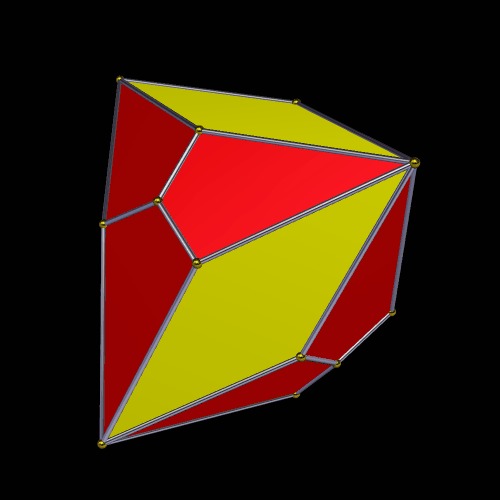
Here is the KRS derived from the truncated cube.

The truncated icosahedron is the “seed” from which the next KRS shown is derived. This KRS is a “stretched” form of a zonohedron called the rhombic enneacontahedron.

Another of these kite-rhombus solids, shown below, is based on the truncated octahedron.
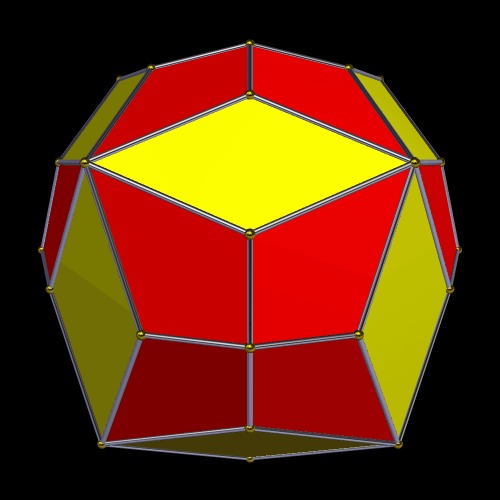
The next KRS shown is based on the rhombcuboctahedron.

Two of the Archimedeans are chiral, and they both produce chiral kite-rhombus solids. This one is derived from the snub cube.

Finally, to complete this set of eight, here is the KRS based on the snub dodecahedron.

You may be wondering what happens when this same process is applied to the other five Archimedean solids. The answer is that all-kite polyhedra are produced; they have no rhombic faces. Two are “stretched” forms of Catalan solids, and are derived from the cuboctahedron and the icosidodecahedron:
If this procedure is applied to the rhombicosidodecahedron, the result is an all-kite polyhedron with two different face-types, as seen below.

The two remaining Archimedean solids are the great rhombcuboctahedron and the great rhombicosidodecahedron, each of which produces a polyhedron with three different types of kites as faces.
The polyhedron-manipulation and image-production for this post was performed using Stella 4d: Polyhedron Navigator, which may be purchased or tried for free at http://www.software3d.com/Stella.php.
Eight Kite-Rhombus Solids, Plus Five All-Kite Polyhedra — the Convex Hulls of the Thirteen Archimedean-Catalan Compounds In a kite-rhombus solid, or KRS, all faces are either kites or rhombi, and there are at least some of both of these quadrilateral-types as faces.
#Archimedean#Catalan#convex hull#dual#duality#geometry#kite#Mathematics#polyehdron#polyhedra#rhombi#rhombus#solid
2 notes
·
View notes

